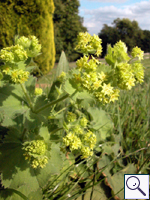|
||||||
|
ALCHEMILLA. Lady's-mantles. [Rosaceae] |
|
|
Fifteen species of Alchemilla are recorded in Britain. Twelve of these are native species including Silver Lady's-mantle (A. conjuncta), Smooth Lady's-mantle (A. glabra) and Garden Lady's-mantle (A. mollis). The BSBI provide a downloadable plant crib for Alchemilla. Three British miners are recorded on Alchemilla. A key to the European miners recorded on Alchemilla is provided in Bladmineerders van Europa. |
|
|
Key for the identification of the known mines of British |
1a > Leaf-miner: Initially a linear mine which later develops into a conspicuous blotch; frass in two rows in linear section, scattered irregularly in the blotch (Spencer, 1976: 134-5, fig. 237, as potentillae). Corridor, gradually and considerably widening towards the end. Frass in two rows in the corridor part, further up dispersed irregularly. Pupation outside the mine. A short broad upper surface corridor leading to a long blotch between veins. |
|
Agromyza idaeiana (Hardy, 1853) [Diptera: Agromyzidae]. |
1b > Leaf-miner: In the first instar the larva mines the leaves, forming short, irregular, blotch-like mines, but in later instars it lives externally, feeding in spun leaves and often twisting those of tender shoots. Larval head light-brown or yellowish brown, edged with black postero-laterally, ocellar area blackish; prothoracic plate black edged with whitish anteriorly; abdomen dull dark green; pinacula distinct, black, sometimes brownish but with black bases to setae; anal plate large, black (Bradley et al., 1973). Small, full depth mine without a definite shape; little frass. Some silk is deposited in the mine. The larva soon leaves the mine and continues feeding among spun leaves. |
|
Cnephasia incertana (Treitschke, 1835) [Lepidoptera: Tortricidae]. |
1c > Leaf-miner: Small (less than 1 cm), full depth blotch, transparent when fresh, starting at the leaf margin, usually near the leaf tip; frass in scattered grains. The larva makes an elliptic double sided excision to form a case. Subsequently, it continues feeding within the case. |
|
Incurvaria praetella (Denis & Schiffermüller, 1775) [Lepidoptera: Incurvariidae]. |
| Last updated 30-Jun-2019 Brian Pitkin | ||

